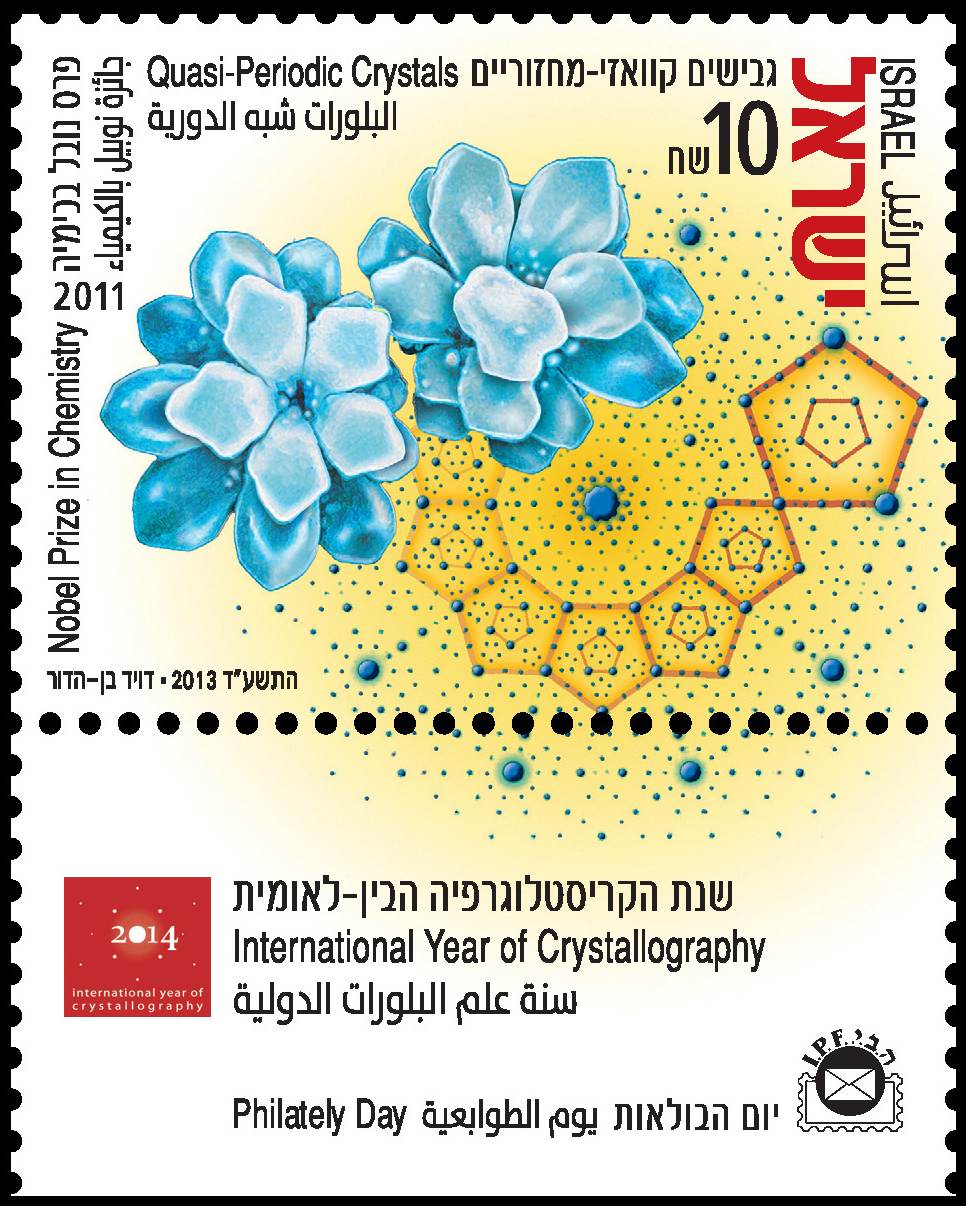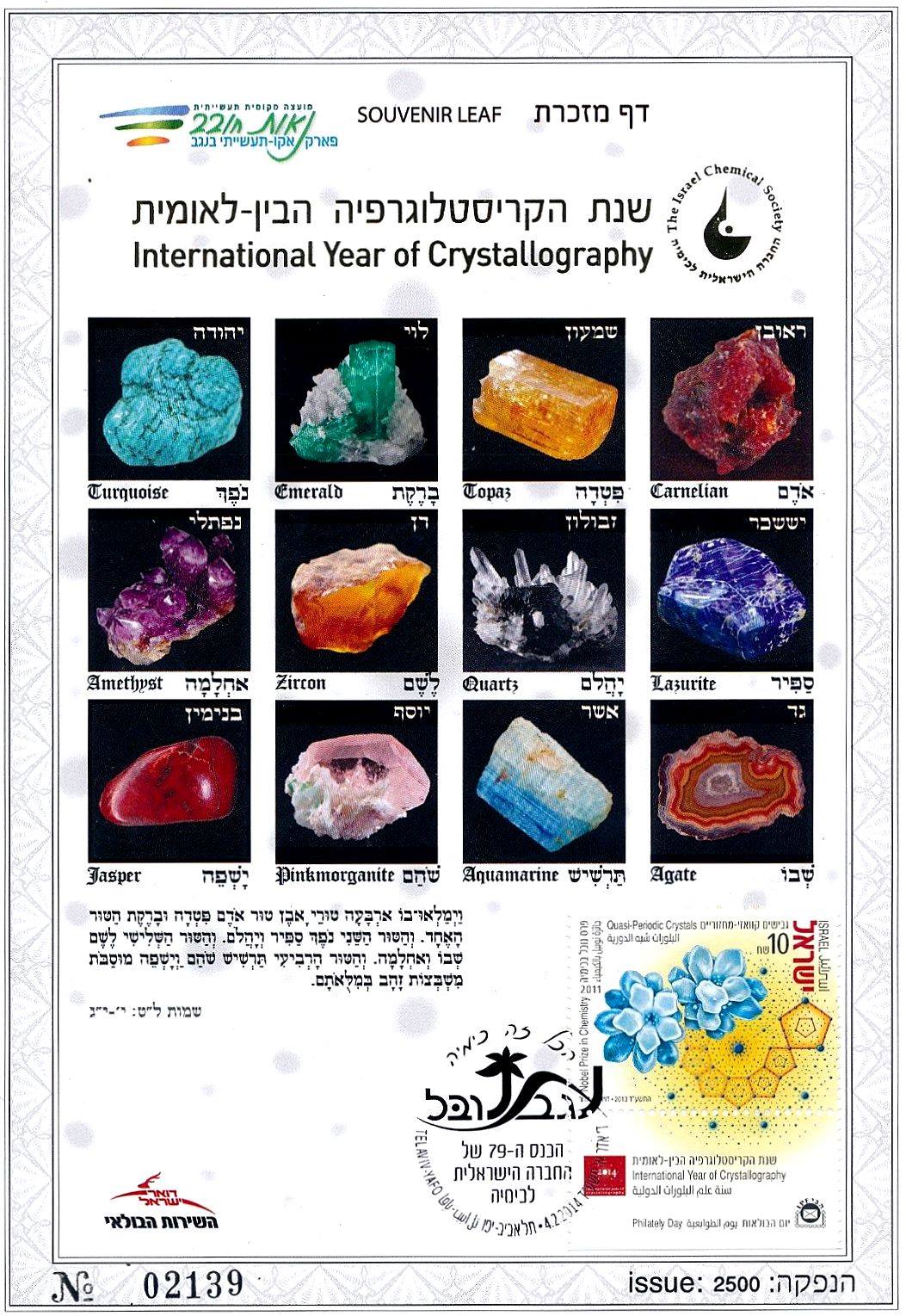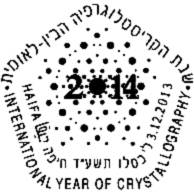
IYCr Philately Day
SPECIAL CANCELLATION חותמת אירוע להופעת הבול
עיצוב בול, מעטפה וחותמת: Stamp, FDC & Cancellation Design: |
גבישים קוואזי-מחזורייםסוג חדש של חומרחומרים גבישיים נמצאים בכל מקום בטבע ומוכרים לכולנו בצורה של אבני חן, פתיתי-שלג נוצצים או גרגרים של מלח. חקר המבנה והתכונות הפנימיות שלהם מעניק לנו הבנה עמוקה לגבי סידור האטומים והמולקולות במצב המוצק, וכך ניתן לקדם את מדעי הכימיה, הפיזיקה, הביולוגיה והרפואה. מאה שנים חלפו מאז הצליח האדם לפענח את סודותיהם של הגבישים על-ידי שימוש בקרני רנטגן. מדע הקריסטלוגרפיה, אשר עוסק בפיענוח המבנה המולקולרי של הגבישים, מאפשר לנו לפענח את מבנה הדנ"א, להבין איך נוצרים חלבונים בתאים, להבין ולייצר שבבי מחשב, ולעזור לנו בתכנון של תרופות חדשות ושפע של חומרים אחרים. זאת הסיבה שביולי 2012 החליטה העצרת הכללית של האו"ם לקבוע את שנת 2014 כשנת הקריסטלוגרפיה הבין-לאומית, לציון 100 שנים להענקת פרס נובל לקריסטלוגרפים הראשונים, אב ובנו, ויליאם הנרי בראג וויליאם לורנס בראג. באפריל 1982 , בעת שחקר סגסוגות של אלומיניום כאורח הסוכנות הלאומית לתקנים במרילנד, ארה"ב, גילה פרופ' דן שכטמן מהטכניון צורה חדשה של חומר: גבישים קוואזי-מחזוריים, הידועים גם בשם קוואזי-גבישים. הגילוי עורר פולמוס מדעי ארוך, ושכטמן נאלץ להקדיש זמן רב בניסיונות לשכנע את עמיתיו בנכונות התגלית שלו. ההישג של פרופ' שכטמן איננו רק גילוי קיומם של הגבישים הקוואזי-מחזוריים, אלא גם ההכרה בחשיבותו של הגילוי ונחישותו לשכנע קהילה מדעית ספקנית. כמעט 30 שנים מאוחר יותר הוכרז פרופ' שכטמן כזוכה היחיד של פרס נובל לכימיה לשנת 2011 . ועדת הנובל הסבירה כי למרות שתגליתו הייתה שנויה במחלוקת, הוא הצליח לגרום לשינוי תיאוריות מדעיות שהיו מקובלות לגבי עצם טבעו של החומר. למעשה, גילוי הגבישים הקוואזי-מחזוריים פתח תחום חדש במדע. מאות חומרים כאלה התגלו ותכונותיהם יוצאות הדופן תוארו באלפי מאמרי מחקר וביותר מ 40- ספרים מדעיים. יתר על כן, לאור פריצת-הדרך של שכטמן, נאלץ האיחוד הבין-לאומי לקריסטלוגרפיה לשנות את ההגדרה הבסיסית של חומר גבישי. אהוד קינןפרופסור לכימיה בטכניון, נשיא החברה הישראלית לכימיה, העורך הראשי של כתב העת הישראלי לכימיה ויו"ר ועדת מקצוע הכימיה של משרד החינוך. תיאור הבול ומעטפת היום הראשוןהתמונה דמוית הפרחים שעל הבול היא תצלום במיקרוסקופ אלקטרונים של צִבְרֵי גבישים קוואזי-מחזוריים של אלומיניום-מַנְגָּן, אשר הוכנו בשנת 1985 על-ידי ד"ר אגנס שאנאדי ועמיתיה במרכז הפיתוח של תעשיית האלומיניום ההונגרית. ברקע שמאחורי "הפרחים" מוצגת תבנית עקיפה של אלומת אלקטרונים, לאחר שפגעה בגבישים קוואזי-מחזוריים. הסימטריה המחומשת המושלמת של תבנית העקיפה מסומנת בתרשים. גם התמונה שעל מעטפת היום הראשון מתארת גבישים קוואזי-מחזוריים של אלומיניום-מַנְגָּן, אשר צולמו במיקרוסקופ אלקטרונים על ידי פרופ' אן-פאנג צאי מאוניברסיטת טוהוקו ביפן.
|
Quasi-Periodic CrystalsA new type of matterCrystals - familiar to all in gemstones, glittering snowflakes or grains of salt - are everywhere in nature.The study of their inner structure and propertiesprovides us with deep insight into the arrangementof atoms in the solid state - insights that advance thescientific fields of chemistry, physics, biology andmedicine. A century has passed since crystals first yielded their secrets through the use of X-rays. Since then, crystallography, which has become the very core of structural science, has allowed us to decipher the structure of DNA, understand and manufacture computer microchips, showed us how proteins are created in cells and helped us to design powerful new materials and drugs. That is why in July 2012 the General Assembly of the United Nations designated 2014 as the International Year of Crystallography, marking 100 years since the Nobel Prize was awarded to the first crystallographers, father and son William Henry and William Lawrence Bragg. In April 1982, while studying aluminum-manganese alloys as a visiting scholar at the National Bureau of Standards in Maryland, USA, Prof. Dan Shechtman of the Technion - Israel Institute of Technology, discovered a new form of matter, quasi-periodic crystals, also known as quasicrystals. The discovery sparked an extended scientific debate and Shechtman was forced to devote much time to convincing his colleagues of the veracity of his discovery. Prof. Shechtman's achievement went beyond the discovery of the quasicrystals themselves, also entailing his recognition of the significance of the discovery and determination to convince the skeptical scientific community accordingly. Nearly30 years later Prof. Shechtman was named the sole recipient of the 2011 Nobel Prize in Chemistry. The Nobel Committee explained that although his discovery was extremely controversial, his work eventually forced scientists to reconsider their conception of the very nature of matter. In fact, thediscovery of quasi-periodic crystals opened up a new field of science. Hundreds of such materials have subsequently been discovered, with their extraordinary properties reported in thousands of research articles and more than 40 scientific books. Furthermore, the International Union of Crystallography revised its basic definition of a crystal in light of Shechtman's breakthrough. Ehud KeinanProfessor of Chemistry at the Technion, President of the Israel Chemical Society, Editor-in-Chief of the Israel Journal of Chemistry and Chairman of the Advisory Council, High School Chemistry Education, Ministry of Education. Description of the stamp and the First Day CoverThe flower-like image on the stamp is an electron microscope photo of icosahedral quasicrystal aggregates of an aluminum-manganese alloy, which were prepared in 1985 by Dr Ágnes Csanády and her colleagues at the Hungarian Aluminum Industry Development Center. The background behind the "flowers" features an electron diffraction pattern from an icosahedral quasicrystal. The perfect pentagonal symmetry is highlighted in the diagram. The image featured on the First Day Cover also depicts quasi-periodic crystals of an aluminum-manganese alloy, which were photographed with an electron microscope by Prof. An-Fung Tsai of Tohoku University, Japan. |
| Location | Israel |
| Contact | Israel Philatelic Service philserv@postil.com |
| URL | http://www.israelpost.co.il/mall.nsf/prodsbycode/761?OpenDocument&L=EN |
| Category | postage stamps |

Thanks to Andre Herzog for this image of his individually-numbered limited-edition first day cover.



